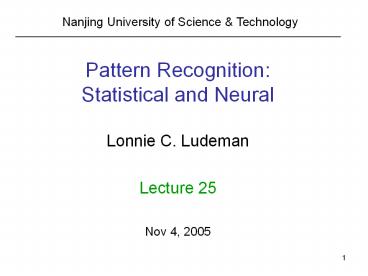Pattern Recognition: Statistical and Neural - PowerPoint PPT Presentation
Title:
Pattern Recognition: Statistical and Neural
Description:
Describe LCLNET: A Neural Network Simulator. Demonstrate the simulator. Show a Simple ... Solve an Abstraction of an image classification problem. Prob 5.19 ... – PowerPoint PPT presentation
Number of Views:35
Avg rating:3.0/5.0
Title: Pattern Recognition: Statistical and Neural
1
Nanjing University of Science Technology
Pattern RecognitionStatistical and Neural
Lonnie C. Ludeman Lecture 25 Nov 4, 2005
2
Lecture 25 Topics
- Describe LCLNET A Neural Network Simulator
- Demonstrate the simulator
- Show a Simple design Prob. 5.18
- Solve an Abstraction of an image classification
problem. Prob 5.19 - 5. Design using a functional link net Prob 5.20
- 6. Design a classifier for vowels Prob.
5.37.
3
Lecture 25Topics
- Describe LCLNET A Neural Network Simulator
- Demonstrate the simulator
- Show a Simple design Prob. 5.18
- Solve an Abstraction of an image classification
problem. Prob 5.19 - 5. Design using a functional link net
- 6. Design a classifier for vowel classification
4
(No Transcript)
5
(B) LCLNET has four active screens
Screen 1. For data selection, training or test
selection, viewing data, creating small
compatible data sets and file management Screen
2. For graphic display of Neural net structure
during training including error waterfall and
throttle for three speeds on graphics, direct
access to changing of all parameters, viewing and
storing weights of design, and easy run again
button.
6
Screen 3. Shows outputs of each node for each
input including per sample error for the training
set. Screen 4. Shows the results of using a test
set other than the training set on your design
sample by sample
7
5.18 Use LCL neural Simulator and Data Set
XORN.DAT (a) 2 Layers (L2) 3 nodes Layer 1,
1node output, Bipolar Activation, train by
sample, n0.7, m0.8, tol0.01, Ng-widrow on,
maxit8000 How many iterations until a design was
obtained? (b) Illustrate your design. (c) Use
n0.7 and m0.8 and structure above run the
simulator 10 times and compute the average number
of iterations for a design
8
(No Transcript)
9
5.19 Continued
- Use the LCL Neural Network Simulator to design a
classifier for the three classes given - Use a logical expression to represent the
solution using the binary training patterns. - Compare the structures of designs in (a) and
(b). - If the training samples were not binary how
could you solve the problem using a neural
network? A logical design? - Classify the following patterns using the neural
net design in (a).
10
- 5.20 Use LCLNET to design a functional Link
Neural Network for the XORN.DAT file. - Use link as y1 y2 y3 y4T x1 x2 x1x2 1 T
- Train the flat net with n0.7, m0.3, tol0.001,
ng-widrow-ON, maxit5000 - Run 10 trial designs and compute the average
number of iterations for a design. - Compare results with those of Problem 5.8.
11
5.37 Design a classifier to separate speech
signals into the vowels a, e, and i. Sample
waveforms below
Speech snipets
12
5.37 Continued
13
5.37 Continued
(a) Design a neural net to serve as a classifier
using the training set Vowel2.dat. Show your
design and the results in testing your design
with the training set. (b) Using your design from
part (a), classify the snipets given in
vowel3.dat. (c) Determine the confusion matrix
for your results. Did the results surprise you?
Explain.
14
5.37 Continued
(d) fvowelt2.dat and fvowelt3.dat are the
magnitudes of some of the components of the
Fourier Transform of vowelt2.dat and vowelt3.dat
respectively. (e) Repeat your design using the
Fourier Transform data and compare your results
with the those determined in parts (a) and
(b). (f) Comment on the importance of using
different features for many pattern
classification designs.
15
Summary Lecture 25
- Describe LCLNET A Neural Network Simulator
- Demonstrate the simulator
- Show a Simple design Prob. 5.18
- Solve an Abstraction of an image classification
problem. Prob 5.19 - 5. Design using a functional link net Prob 5.20
- 6. Design a classifier for vowels Prob.
5.37.
16
End of Lecture 25































